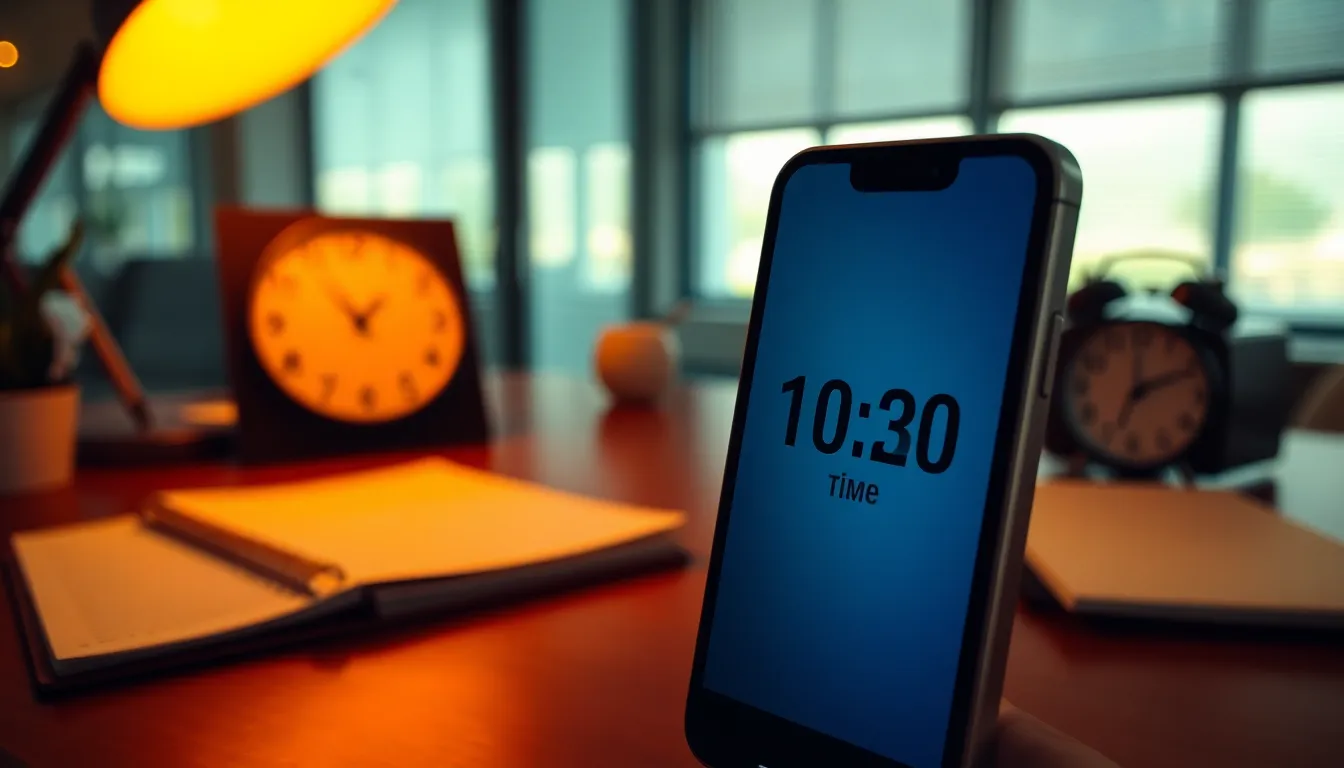Time’s a tricky little beast, isn’t it? One moment, you’re sipping your morning coffee, and the next, you’re wondering how long until 2:15 PM. Whether it’s for that important meeting, a much-anticipated lunch date, or just a chance to sneak in a power nap, knowing how much time you have left can be a game changer.
Table of Contents
ToggleUnderstanding Time Calculations
Understanding time calculations is crucial for managing daily routines. It plays a key role in various aspects of life, from professional commitments to personal activities.
Importance of Knowing Time Intervals
Knowing time intervals enhances efficiency significantly. It helps individuals plan their schedules accurately, ensuring timely arrivals for appointments. Awareness of time allows for better prioritization of tasks, leading to improved productivity. Recognizing how long until a specific time, such as 2:15 PM, enables smooth transitions between activities. Efficient time management fosters a sense of control, which can reduce stress and increase satisfaction throughout the day.
Everyday Scenarios for Time Awareness
Time awareness comes into play in various everyday scenarios. People often find themselves needing to catch a bus or prepare for an important meeting. Understanding how long until a specific time aids in avoiding last-minute rushes. Daily routines, such as cooking dinner or completing work assignments, become more manageable with a grasp of time intervals. Scheduling social activities, like lunch dates with friends or family gatherings, benefits from knowing exact time frames, allowing for easier coordination and enjoyment.
Methods to Calculate Time Remaining

Calculating time remaining until a specific hour, like 2:15 PM, involves simple techniques and digital tools that streamline the process.
Simple Mental Math Techniques
Estimating time left can often be done through straightforward arithmetic. Subtract the current hour and minutes from the target time of 2:15 PM. For instance, if it’s 1:45 PM, subtract 1:45 from 2:15. The result shows a remaining time of 30 minutes. Multiples of 15, like 1:00 PM, simplify calculations further. Converting hours into minutes helps too; 2 hours equals 120 minutes. This method enhances efficiency in quickly assessing schedules.
Using Digital Tools for Time Calculation
Many digital tools assist with time calculations. Smartphones and computers typically have built-in clock features for quick checks. Apps can provide countdown timers, which display the exact time remaining until an event, such as a meeting or appointment. Calendar applications often send reminders, enhancing planning accuracy. Setting alarms for specific times also proves handy, ensuring punctuality. Using these tools increases productivity while reducing the cognitive load associated with manual calculations.
Real-Life Applications
Grasping time dynamics has crucial implications for everyday life. Understanding time intervals directly impacts how individuals organize their daily activities, from personal errands to professional commitments.
Planning Your Day Effectively
Effective planning hinges on recognizing how time accumulates throughout the day. Start by examining the time remaining until key moments, such as 2:15 PM. This awareness allows individuals to allocate specific block periods for tasks. Prioritization emerges when one assesses the urgency of activities against the clock. For instance, if it’s 10:00 AM, knowing 5 hours remain until 2:15 PM helps in establishing a balanced task list for the day. Breaks can also be scheduled effectively to maintain energy levels. Utilizing calendars or digital tools further aids in creating a structured timeline, ensuring timely completion.
Managing Appointments and Meetings
Managing appointments requires precision and mindfulness regarding time. Understanding remaining minutes until a meeting can enhance punctuality. If the current time is 1:30 PM, knowing there’s 45 minutes until the 2:15 PM appointment enables adequate preparation by gathering materials or planning transportation. Set reminders for key appointments to avoid last-minute rushes. Utilizing visual cues, such as clocks and timers, reinforces time awareness, enhancing focus before meetings. Respecting time commitments fosters a professional image and builds trust in relationships. Planning thus becomes a crucial step toward effective appointment management.
Common Misconceptions
Misunderstandings regarding time often arise in various contexts, leading to confusion in scheduling and planning.
Confusion with Time Zones
Time zones frequently create confusion when calculating hours. Eastern Standard Time (EST) differs from Pacific Standard Time (PST) by three hours. If someone in New York schedules a meeting for 2:15 PM, it occurs at 11:15 AM in Los Angeles. Coordinating meetings across time zones necessitates awareness of these differences to prevent miscommunication. Using digital tools can help clarify time zones, ensuring everyone understands the correct timing. It’s essential to verify the time zone of the target hour to enhance accuracy.
Effects of Daylight Saving Time
Daylight Saving Time can complicate time calculations further. Clocks spring forward in March and fall back in November, altering the usual calculations by one hour. When shifting to Daylight Saving Time, 2:15 PM in standard time becomes 3:15 PM. This adjustment can cause missed appointments and complicate personal schedules. Awareness of these shifts is crucial. Relying on calendar apps that adjust automatically for daylight saving changes ensures accurate time management and fewer scheduling mishaps. Understanding these effects leads to better planning and reduces stress.
Time awareness is essential for navigating daily life effectively. Recognizing how much time remains until specific moments like 2:15 PM can enhance scheduling and reduce stress. By mastering simple calculations and utilizing digital tools, individuals can improve their punctuality and manage their commitments more efficiently.
Understanding time not only facilitates smoother transitions between tasks but also fosters a sense of control over one’s day. As people become more attuned to the passing minutes, they can prioritize their activities better and maintain a professional image. Embracing these strategies empowers individuals to make the most of every moment, ultimately leading to a more productive and fulfilling day.



